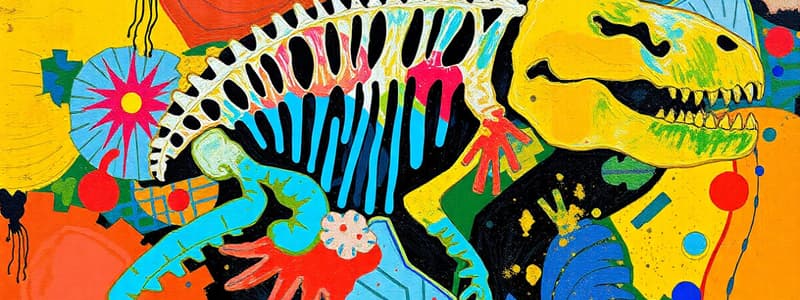Podcast
Questions and Answers
What are the two major types of fossils?
What are the two major types of fossils?
- Plant fossils and animal fossils
- Living fossils and extinct fossils
- Body fossils and trace fossils (correct)
- Rock fossils and mineral fossils
What primarily happens to soft tissues after a plant or animal dies in a watery environment?
What primarily happens to soft tissues after a plant or animal dies in a watery environment?
- They are preserved indefinitely
- They turn into body fossils
- They become fossils immediately
- They quickly decompose (correct)
Which of the following is NOT a stage of fossilization?
Which of the following is NOT a stage of fossilization?
- Burial of remains
- Chemical alteration of soft tissues (correct)
- Sediment layer pressing down
- Fossils becoming visible through erosion
What does the word 'dinosaur' mean?
What does the word 'dinosaur' mean?
What led to the creation of mineralized fossils?
What led to the creation of mineralized fossils?
Which of the following best describes Argentinosaurus?
Which of the following best describes Argentinosaurus?
What role do paleontologists play in the study of fossils?
What role do paleontologists play in the study of fossils?
What must occur for fossils to be uncovered?
What must occur for fossils to be uncovered?
What does the name Apatosaurus mean in Greek?
What does the name Apatosaurus mean in Greek?
What physical characteristic is unique to Stegosaurus?
What physical characteristic is unique to Stegosaurus?
What type of diet did Ankylosaurus have?
What type of diet did Ankylosaurus have?
Which dinosaur is closely associated with three horns and a frill at the back of its skull?
Which dinosaur is closely associated with three horns and a frill at the back of its skull?
Compsognathus is characterized as what type of dinosaur?
Compsognathus is characterized as what type of dinosaur?
What distinguishes Pterosaurs from dinosaurs?
What distinguishes Pterosaurs from dinosaurs?
Which of the following is a suggested cause of extinction for dinosaurs?
Which of the following is a suggested cause of extinction for dinosaurs?
What are Ichthyosaurs closely related to?
What are Ichthyosaurs closely related to?
Flashcards are hidden until you start studying
Study Notes
Fossils
- Fossils are preserved remains or traces of ancient life.
- Paleontologists are scientists who study prehistoric life.
- The study of fossils is called Paleontology.
- There are two main types of fossils: Body fossils and Trace fossils.
- Body fossils are actual parts of an organism, like bones, teeth, shells, and leaves.
- Trace fossils are evidence of animal life, like footprints, burrows, or nests.
- Most fossils are formed when a plant or animal dies in a watery environment and is buried in mud and silt.
- Over time, sediment builds up and hardens into rock, preserving the hard parts of the organism.
Formation of Fossils
- Fossils are formed over time, through a process called fossilization.
- Fossils are formed in four main stages:
- The organism dies and is buried before it decays completely.
- Sediment layers build up and press down on the remains.
- Dissolved minerals fill in the spaces in the bones, transforming them into fossils.
- The fossils remain in the rock until exposed through erosion or excavation.
Dinosaurs
- Dinosaurs were reptiles that lived on Earth between 224-65 million years ago.
- The word "dinosaur" comes from the Greek words "deinos" (terrible) and "saurus" (lizard).
Examples of Dinosaurs
- Tyrannosaurus rex (T. rex): A fierce predator, often called the "king of the tyrant lizards".
- Argentinosaurus: The largest dinosaur and land animal ever known.
- Apatosaurus: A long-necked, plant-eating dinosaur with four massive legs.
- Stegosaurus: A large, plant-eating dinosaur with bony plates along its back and a very small brain.
- Ankylosaurus: A large, armored dinosaur with a clubbed tail and a wide, skull.
- Triceratops: A rhinoceros-like dinosaur with three horns and a bony frill around its skull.
- Compsognathus: One of the smallest known dinosaurs, a carnivore that ate small animals.
- Pterosaurs: Flying reptiles that were more closely related to birds and dinosaurs than to crocodiles.
Extinction of Dinosaurs
- There are several theories about the extinction of dinosaurs:
- A large asteroid impact that changed the climate.
- Volcanic eruptions that released ash and gas, suffocating dinosaurs.
- Diseases that wiped out large populations.
- Imbalances in the food chain leading to starvation.
Trivia
- Ichthyosaurs were not dinosaurs but ancient marine reptiles, similar to dolphins or fish.
- The name "Ichthyosaur" comes from Greek and means "fish lizard".
Studying That Suits You
Use AI to generate personalized quizzes and flashcards to suit your learning preferences.




